Suryapurno Suvarna Yug Yane Suratno Jain Itihas
Added to library: September 2, 2025

Summary
Here's a comprehensive summary of the Jain text "Suryapurno Suvarna Yug Yane Suratno Jain Itihas" by Kesharichand Hirachand Zaveri:
Book Title: Suryapurno Suvarna Yug Yane Suratno Jain Itihas (The Golden Age of Suryapur, That is, The Jain History of Surat) Author: Kesharichand Hirachand Zaveri Publisher: Motichand Maganbhai Choskhi, Shri Jain Sahitya Kund, Surat Catalog Link: https://jainqq.org/explore/032631/1
This book is a detailed chronicle of the Jain community in Surat, Gujarat, tracing its history from ancient times to the late 19th century (Vikram Samvat era). The author, Kesharichand Hirachand Zaveri, meticulously compiles information from various sources, including inscriptions, manuscripts, historical texts, and oral traditions, to present a comprehensive picture of the Jain presence and influence in Surat, which was also known as Suryapur.
Key Themes and Content:
-
Origin and Naming of Surat (Suryapur): The book delves into the various legends and historical accounts surrounding the founding of Surat. While acknowledging popular folklore, it also presents more academically grounded theories, suggesting a connection to figures like Gopi and exploring the etymology of the city's name.
-
Early Jain Presence: The text highlights the ancient roots of Jainism in Surat, citing inscriptions from the 15th century (Vikram Samvat) that mention Jain Tirthankara images and their patrons. This indicates a significant Jain community and religious activity even in that early period.
-
The Golden Age (Suvarna Yug): The book extensively details the flourishing period of the Jain community in Surat, particularly during the 17th and 18th centuries (Vikram Samvat). This era saw the construction of numerous temples, upashrayas (monastic residences), and libraries. The patronage of wealthy Jain merchants and their significant contributions to religious and public life are emphasized.
-
Prominent Jain Acharyas and Their Activities: The text meticulously documents the visits and activities of various prominent Jain Acharyas from different gacchas (sects) like Tapagachha, Kharatargachha, and Anchalgachha. It records their presence in Surat, their scholarly debates (shastrartha), their teachings, and the establishment of Jain institutions under their guidance. The influence of figures like Hiravijayasuri, Vijayasen asuri, and Jinachandrasuri is highlighted.
-
Saints and Scholars: The book lists numerous Jain monks, scholars, and poets who either resided in Surat, visited it, or contributed to Jain literature and philosophy from or about Surat. Their works, often commissioned by wealthy patrons, are mentioned, providing insights into the intellectual and spiritual life of the community.
-
Patronage and Philanthropy: A significant portion of the book is dedicated to the immense philanthropic activities of the wealthy Jain merchants of Surat. It details the construction of numerous temples, upashrayas, dharamshalas (rest houses), libraries, educational institutions, and public welfare projects like cattle protection (panjarapole) and funds for the needy. The names of prominent families and individuals who made these contributions are listed, showcasing their generosity and commitment to the Jain faith and the welfare of the city.
-
Sects and Their Presence: The book notes the presence of various Jain sects (gachhas) in Surat, such as Tapagachha, Kharatargachha, Anchalgachha, and Lunka sect. It discusses their activities, the establishment of their respective institutions, and sometimes their theological differences. The mention of Lavanji Muni and the emergence of the "Dhundhiya" sect is discussed, highlighting internal developments within Jainism.
-
Jain Shrines and Institutions: The text provides detailed descriptions and historical context for numerous Jain temples and institutions in Surat. It lists their locations, the Tirthankaras worshipped there, and the periods of their construction or renovation. The importance of the "Heervihar" and its significance is elaborated.
-
Sangs (Pilgrimage Groups): The book recounts the history of Jain sangs (pilgrimage groups) organized from Surat to prominent Jain pilgrimage sites like Shatrunjaya. The detailed descriptions of these sangs, their organizers, the challenges they faced, and the rituals they performed offer a glimpse into the devotional practices of the community. The journey of Premji Parekh and Kapurchand Bhansali's sang is particularly detailed.
-
Literary Contributions: The author meticulously lists numerous Jain literary works, including Rasas (narrative poems), Stotras (hymns), and commentaries, composed in Surat or by Jain scholars associated with the city. This section highlights Surat's role as a center of Jain literary activity.
-
Social and Economic Life: While primarily focusing on religious and historical aspects, the book also touches upon the social and economic fabric of the Jain community in Surat. It mentions the prominent professions of Jain merchants, their wealth, and their contributions to the city's prosperity. The impact of historical events like the decline of port trade and natural calamities on the city is also alluded to.
-
Challenges and Decline: The book implicitly acknowledges periods of hardship, such as invasions, natural disasters (floods, fires), and political instability, that affected Surat and its Jain community. However, it consistently emphasizes the resilience and continued contributions of the Jains.
Author's Approach:
Kesharichand Hirachand Zaveri, the compiler, expresses his deep connection to his hometown, Surat, and his motivation to preserve its Jain heritage. He acknowledges that the work is based on available materials and hopes that future researchers will uncover more details. The author also admits to potential inaccuracies in dating and transcription due to the extensive nature of the research and the varied sources used.
Significance:
"Suryapurno Suvarna Yug Yane Suratno Jain Itihas" is a valuable resource for understanding the history of Jainism in a specific region of India. It provides a detailed and chronological account, emphasizing the significant contributions of the Jain community to the religious, cultural, and economic life of Surat. The book serves as a testament to the enduring legacy of Jainism and the dedication of its followers in preserving their heritage.